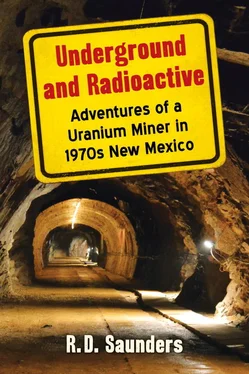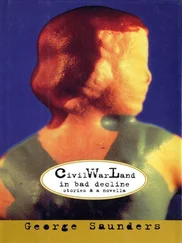Sometimes I’m asked how safe it was to be around uranium ore. I learned in orientation that a small chunk of uranium ore has about as much radiation as a bunch of bananas. Much later I looked that up and found it to be true as bananas contain radioactive isotope potassium–40.
I had many questions, the sheer number of which would have taken up an hour or more. I had no intention of drawing that kind of attention to myself among this group of veteran miners. I wasn’t about to ask what a drift was, what a ballroom was, what a trip light was, and what exactly was meant by “run over again.” But it seemed safety was to be taken seriously, and I liked the sound of that. More proof I knew nothing about contract mining, where every safety regulation cost a miner time and thus money.
Orientation continued for the promised three days, and as it progressed I slowly learned what many of the terms being referred to meant. But having never been underground, I found it difficult to visualize what a mine really looked like. Still, I resolved not to make any inquiries of the instructor so as not to draw attention to myself as the no-experience new guy.
Today if I am ever asked what a mine looks like, I’ll say, “Think of an ant farm.” Looking at a map of the mine I worked in always reminds me of an ant farm.
Smoke and coffee breaks came and went, during which there were many opportunities to talk to the real miners, but I didn’t try it. They stayed to themselves, and none of them seemed approachable; certainly none bothered to so much as look my way, and I don’t blame them. I couldn’t speak the language anyway, so even if anyone had shown some empathy, I couldn’t have said much other than to ask a slew of elementary questions.
It was in orientation that I discovered I was not a miner, not because I had never been underground before, but rather no matter how far underground I might venture, it seemed the title of miner was something to be earned not bestowed upon just anyone.
Unfortunately for my ego, it became clear during the class that just because I was an employee of Kerr-McGee and would be working underground, I wouldn’t be a miner. That was disappointing. Going in I’d simply assumed that everyone working underground was a miner. I’d seen the photographs of the guys with the hard hats with the lights on top and thought that those guys were miners. That evidently was not necessarily the case.
Orientation taught me that I was a laborer who happened to be working underground and wouldn’t be doing any mining at all and would instead be performing any task the shift boss deemed necessary, other than mining. In fact, as it turned out, I wouldn’t even see a real miner except before shift, at lunch break, and after shift. I was very disappointed.
Although the instructor covered a wide variety of topics, he missed a couple of the important ones that would have been useful to any new guy going underground for the first time. One of them was what to wear.
When I had reported to Shotgun at Section 35, I thought I was dressed for work underground with my straight-leg Levi’s, flannel work shirt, and leather roper boots. If I had been allowed underground dressed like that, then whatever work I managed to get accomplished would have quickly shredded my clothing and ruined my boots in a matter of hours.
Fortunately, the instructor did hand out a list of all the equipment each worker would need to purchase before reporting to their mine. I was probably the only person in orientation who took that paper with me, because those other guys already had their gear.
There was a lot of personal equipment on the list, including a hard hat, miner’s belt, miner’s rubber boots with steel toes, pipe wrench, safety glasses, gloves, and ear plugs. Sadly, there was no mention of what type of clothing a laborer should wear.
There were several mine supply stores in the Ambrosia Lake area where all the necessary items mentioned on my list could be purchased. My biggest worry was that I needed size 14 steel-toed, high-rise rubber boots. Shoes could always be a problem in general, I’d found, but to the mining supply companies in the area, it wasn’t. Lots of large men worked the mines, so my size 14 boots were readily available. The bigger issue was the hard hat.
There are a few shapes of hard hats that underground workers wear. Selection is by choice, and while style is a part of it, functionality is a larger component. Those who work beneath the water table in predominantly wet conditions tend to wear hard hats that have a wide brim, while those working in a dry area of the mine often use a hard hat that more closely resembles a baseball batting helmet.
There were various colors of hard hats to choose from too, but other than style preference, I never knew the significance of them. Although I preferred the baseball type, in the end I chose a hardhat with a brim that went all the way around. If I worked in a wet area, I’d be covered, and if I worked in a dry place, the hat would still work. My biggest problem in the hard hat area was that it was new and shiny white. I might as well have worn a nameplate on my head that said, “New Guy.”
It was easy to identify old hands by their hard hats. Most guys tended to advertise on them all the companies they had worked for during their careers by affixing company stickers. But the main feature of the hard hat of an experienced hand was that it was beat up. Anyone who had worked underground for any length of time had a hard hat that was pretty well beaten and scraped and permanently dirty, while a new guy had a hard hat that was clean and shiny, sticking out like a gold nugget in a sea of coal. That was to be me with my new, pristine, pretty white hard hat.
There are a couple of other pieces of mandatory equipment I should mention. One is the pipe wrench. Every person who works underground has one, as its uses are many. It can be anything from a hammer to an actual wrench, but you quickly learn it can be used in many ways. I would never leave the Dry without it attached to my safety belt in its homemade pipe wrench holster made of a piece of old rubber hose.

Self-rescue unit (left) and lamp battery (right). Worn on the miner’s belt, they were a heavy combination. The self-rescue unit provided emergency short-term air purification against toxic carbon monoxide such as that encountered by a miner caught in smoke or fire (photograph by R.D. Saunders from an exhibit courtesy New Mexico Mining Museum).
The other piece of mandatory equipment was the self-rescue unit. Worn on the belt, the self-rescue unit supposedly provided a worker with about fifteen minutes of breathable air should he find himself in a situation where it was needed. It would be a while before I found out what that situation was, but carrying it did seem like a good idea. So despite its weight, I happily lugged it around.
Besides being heavy, the main drawback to the unit was that it became extremely hot during use, and the wearer could suffer burns to the mouth. I found another inconvenient aspect of the self-rescue unit to be that it occasionally made it difficult to squeeze through tight spaces, of which there were many underground, and that it frequently got caught on ladders in manways.
I knew the work was rough, so I had decided to wear the most durable clothing that I had, my straight-leg Levis and a flannel work shirt. Not good, but it was all I had and all I knew.
My clothing problems began with the straight-leg pants. The high-topped, brand-new rubber boots didn’t fit under the straight-leg jeans, so I had to wear mine over the pants. For a very few well-seasoned miners, this worked fine, but it wasn’t a good look for a new guy. And the flannel shirt, in addition to soaking up every possible ounce of water and sweat, wouldn’t last more than a couple of shifts before falling apart.
Читать дальше













